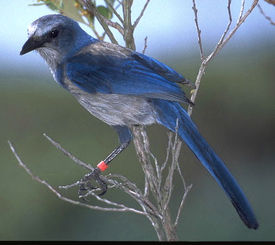|
Aphelocoma |

Florida Scrub Jay
|
|
Scientific classification |
|
|
| Species |
Aphelocoma californica
Aphelocoma coerulescens
Aphelocoma insularis
Aphelocoma ultramarina
Aphelocoma unicolor |
The
passerine
birds of the genus Aphelocoma[1]
include the three
scrub jays and two other jays. They are New World jays found
in Mexico, western Central America and the western United
States, with an outlying population in Florida. This genus
belongs to the group of New World (or "blue") jays -
possibly a distinct subfamily - which are not closely related to other jays,
magpies or treepies (Ericson et al, 2005).
Species
Five species of Aphelocoma are now recognized,
since two taxa formerly treated as races of A.
coerulescens were recently split off as separate species
(A. californica and A. insularis); the 3 now
separate species differ in color and bill size. They are
believed to have evolved in the
Pleistocene, and the Floridan species is known to have
been recognizably distinct and present in its current range
for at least 2 million years (Emslie, 1996).
- Western Scrub Jay A. californica – western United
States from Washington to west Texas and south to Baja
California and central Mexico
Florida Scrub Jay A. coerulescens – Florida
Island Scrub Jay A. insularis – Santa Cruz Island off
southern California
Mexican Jay or Gray-breasted Jay Aphelocoma ultramarina
– Sierra Madre Oriental and Sierra Madre Occidental
mountains of Mexico, north to southeast Arizona,
southwest New Mexico and westernmost Texas, US.
Unicolored Jay Aphelocoma unicolor – southern Mexico
east to Honduras
They live in open
pine-oak forests and chaparral scrub habitats.
Appearance
Aphelocoma jays are slightly larger than the
Blue Jay and differ in having a longer tail, slightly
shorter, more rounded wings, and no crest on the head. The
top of the head, nape, and sides of the head are a rich deep
blue. In some species have a white stripe above the eye and
dark ear coverts. The breast is also white or grey-white and
the back is a grey-brown contrasting with the bright blue
tail and wings in most species. One species, Unicolored Jay,
is blue all over, superficially similar to the
Pinyon Jay from much further north. The bill, legs, and
feet are black.
Behavior
Food is taken both on the ground and in trees. Acorns and
pine nuts are the most important foods, making up the great
bulk of the diet, with grain, berries and other fruits
making up the rest of the vegetable diet. Many insects and
other invertebrates are also taken, and eggs and nestlings,
small frogs, mice and reptiles.
Wild Aphelocoma jays are frequent visitors at
campsites and picnics and have frequently learned to eat
from the hands of people where they have become accustomed
to being fed.
The nest is in a tree or a bush, sometimes quite low
down. The nests are compact and lined with hair and fine
roots with an outer diameter of about 30cm to 60cm. Usually
2 to 4 eggs are laid and incubated over 14 to 16 days. There
are two main variations of egg shell color: green with olive
markings or a paler background of grayish-white to green
with red-brown markings. The Florida Scrub Jay and the
Mexican Jay both have
cooperative breeding systems involving several 'helpers' at
each nest, usually siblings of the main
pair.
Aphelocoma jays are quite vocal and have a huge
range of sounds and calls; common calls include a cheek,
cheek, cheek and a guttural churring krr'r'r'r'r.
Aphelocoma jays are also, like all other jays,
oftentimes quite aggressive at feeding areas, and sometimes
regarded as a nuisance.
References
- Emslie, Steven D. (1996): A fossil Scrub-Jay
supports a recent systematic decision.
Condor 98(4): 675-680.
PDF fulltext
- Ericson, Per G. P.; Jansén, Anna-Lee;
Johansson, Ulf S. & Ekman, Jan (2005): Inter-generic
relationships of the crows, jays, magpies and allied
groups (Aves: Corvidae) based on nucleotide sequence
data. Journal of Avian Biology 36:
222-234.
PDF fulltext
Footnotes
- ^
Aphelocoma, from
Ancient Greek aphelo-, "smooth" and
Latin coma "hair", in reference to the smooth
plumage of birds of this genus compared to other corvids.
External links




